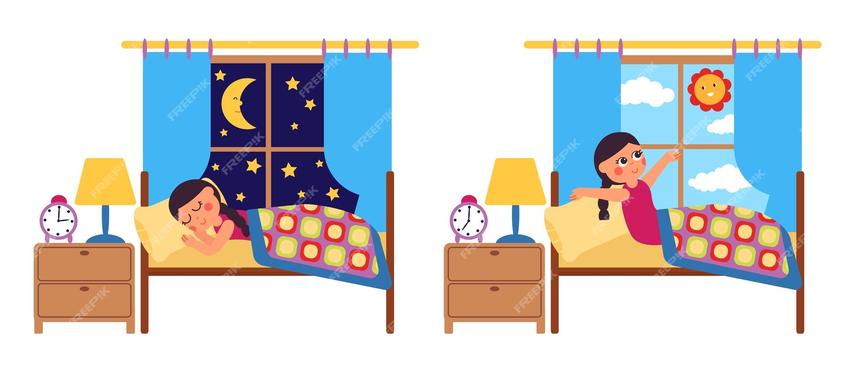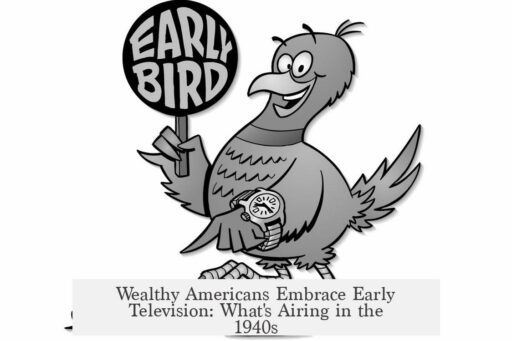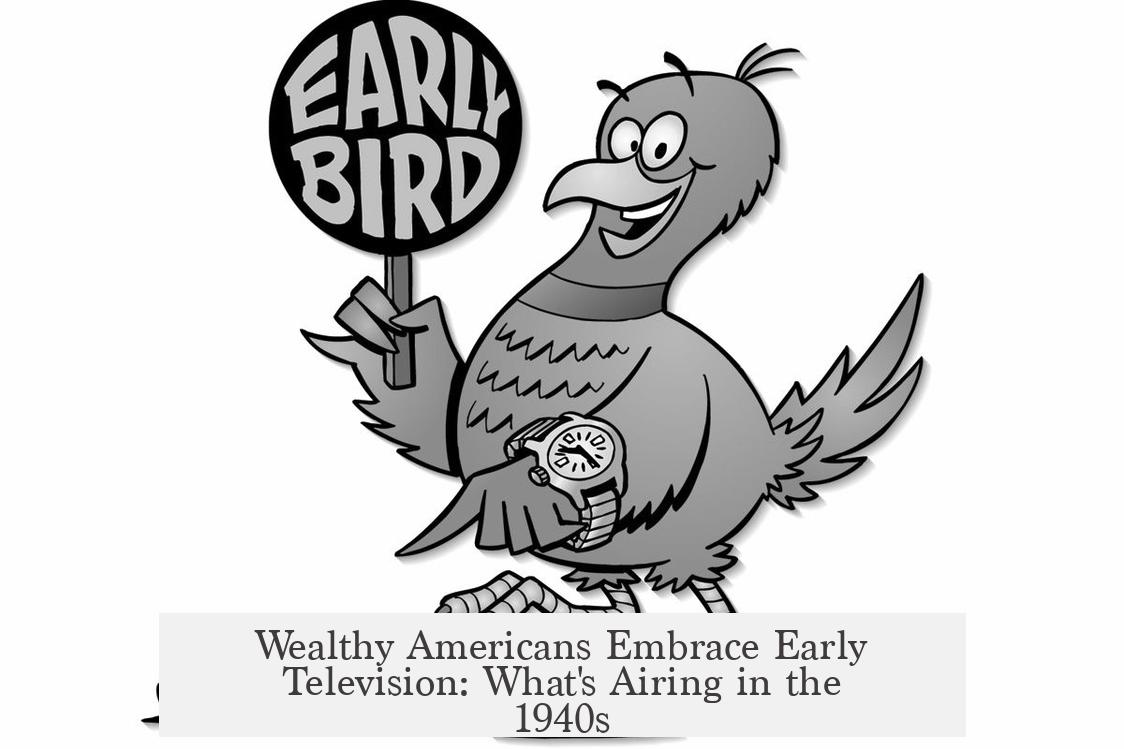As a wealthy American early adopter of television in the 1940s, your viewing options include a blend of entertainment, education, sports, and experiments with new formats available through the limited but emerging TV networks of the time.

By 1946, television is still a novelty, with very few households owning sets. The market is dominated by NBC and DuMont, with CBS just beginning to enter and ABC staying on the sidelines due to financial constraints. Programming is sparse and experimental, often broadcast live and primarily sponsored by single advertisers, a practice known as mono-sponsorship.
Typical evenings might include watching I Love to Eat, the first TV cooking show hosted by James Beard, which sets the foundation for later culinary programing. You could also find educational content like You Are An Artist, which teaches viewers to draw, hosted by Jon Gnagy. This instructional style blends entertainment with practical teaching, showing the innovative spirit of early television.

For entertainment, variety and novelty acts are common. Shows like Face to Face, where a cartoonist draws a person based solely on verbal descriptions, provide uniquely visual storytelling. Dance enthusiasts would enjoy Let’s Rhumba, introducing Latin dance moves to American living rooms. These programs highlight television’s role as both educator and entertainer.
Sports broadcasting, meanwhile, plays a pivotal role in television’s appeal. Boxing stands out as the king of televised sports due to its cost-effectiveness and wide appeal. The Gillette Cavalcade of Sports regularly features boxing matches, including historic bouts such as Joe Louis versus Billy Conn, which drew significant audiences. This demonstrates early television’s focus on accessible, engaging live events to attract viewers.

Drama and soap operas are in their infancy. Faraway Hill on DuMont is the first soap opera on TV, exploring themes of social class and romance. It signals the beginning of serialized storytelling, a format that will flourish as production capabilities improve.
Game shows offer light entertainment with interactive qualities. Programs like Play the Game, essentially charades, and You Be the Judge, which reenacts real court cases with guests deciding outcomes, engage the audience in participatory ways. Female-focused shows like Missus’ Goes-A-Shopping broadcast from Manhattan supermarkets and appeal to niche demographics.
The broadcasts remain localized and sparing in schedule. Stations like New York’s experimental W2XAB example the early programming mix, ranging from musical performances and poetry to educational segments. By 1949, programming diversifies further, introducing iconic shows such as Howdy Doody, The Goldbergs (transitioned from radio), Ripley’s Believe It or Not, The Lone Ranger, and Candid Camera. The launch of Captain Video and His Video Rangers includes fan engagement through secret decoder rings.
The rise of television foreshadows the decline of radio, although in the mid-1940s, radio remains dominant in most American homes. Television’s mono-sponsorship advertising model lets companies tie their brand identity closely to programs. For example, Gillette’s name is integrated throughout Gillette Cavalcade of Sports, demonstrating early synergy between content and commercial interests.
| Year | Networks Available | Notable Programming | Programming Features |
|---|---|---|---|
| 1946 | NBC, DuMont; CBS limited | I Love to Eat, Faraway Hill, Play the Game | Live broadcasts, educational shows, early soap opera, game shows |
| 1949 | NBC, DuMont, CBS expanding | Howdy Doody, The Goldbergs, The Lone Ranger | Variety shows, children’s programming, serialized drama, fan interactions |
As a wealthy individual, the acquisition of a television set places you among a very small and elite group of viewers in 1946-49 America. Your programming schedule comprises a curated mix of live performance, educational content, sports, and nascent story-driven shows. These programs are broadcast in black and white, filling only a few hours of the day, often in the evening.
Television remains in its infancy. Networks experiment with formats and genres. You witness innovations like demonstrations for the blind, Latin dance lessons, and reinterpretations of court proceedings. Your viewing habits likely include attending demonstrations or social gatherings to experience television’s novelty firsthand, a testament to your social status.
Early television opens a new world of visual entertainment, aiming to captivate and educate. It sets foundations for future mass media. Its limited availability means programs remain unique and exclusive, enhancing your appeal as a pioneer viewer.
- Television ownership in the 1940s is rare; NBC and DuMont dominate early programming with CBS and ABC lagging behind.
- Popular formats include cooking shows, educational art classes, live sports, soap operas, and game shows.
- Boxing rules sports TV, with notable broadcasts like the Joe Louis-Billy Conn fight.
- Advertising operates on a single-sponsor model, integrating brands closely into shows.
- The 1940s TV experience is limited, live, and experimental but lays groundwork for future rapid growth.
I’m a Wealthy American Early Adopter of TV in the 1940s. What’s On?
As an affluent American plugged into one of the few television sets in the mid-1940s, your channel surfing options are modest but fascinating. The year 1946 marks the dawn of television as a household pastime, and your living room is a gateway to experimental shows, pioneering sports broadcasts, and the roots of TV culture itself.
Let’s step into your polished leather armchair, gaze at the glowing cathode ray tube, and explore what *really* flickers across your 1940s screen.
The TV Early Days: From Scarce to Sparkling
By 1946, owning a television isn’t just rare—it’s downright exclusive. Mere thousands of sets exist nationwide. If you’re wealthy enough to boast one, congratulations—you’re practically a social celebrity. Only NBC and DuMont are broadcasting at scale, with CBS limping behind and ABC still figuring out finances.
In 1949, TVs have entered 6% of homes. That sounds small, but 44% of Americans have at least glimpsed one. The buzz everywhere is that television will overtake radio. Surely, you’ve heard the chatter and know that change is imminent. Yet today, your interests lie in what *you* can watch right now.
What’s on the Box? — NBC’s Eclectic Mix
You turn on NBC and are greeted by a unique brew of shows. Forget the Netflix rabbit hole; here’s real innovation unfolding before your eyes.
- I Love to Eat — An early cooking show hosted by none other than James Beard. Long before Food Network, Beard teaches you how to delight your palette. Sponsored by Borden, it’s charming and practical. You might consider whipping up some recipes inspired by this show at your next dinner party.
- You Are An Artist — Hosted by Jon Gnagy, this show teaches viewers how to draw. Drawing lessons? On TV? For adults and kids, it’s a creative haven on this new medium. Imagine showing off your art skills, learned to some extent from your television lessons—fancy, no?
- Face to Face — Picture this: a cartoonist sketches a stranger based solely on a verbal description. You watch as imagination turns into ink strokes. It’s a quirky affair, engaging your sense of humor and curiosity.
- Let’s Rhumba — Want to learn Latin dance steps? This sponsored dance tutorial invites viewers to shimmy in their living rooms, because why should the radio have all the fun?
- Gillette Cavalcade of Sports — Boxing reigns supreme on television. It’s the sport of choice because it’s compact and easy to broadcast from indoor venues. The famous Joe Louis vs. Billy Conn match in 1946 was broadcast to over a hundred thousand viewers. Imagine that—front-row access without leaving your mansion!
DuMont’s Creative Corners
Not to be overlooked, DuMont is carving its niche with some lively programming:
- Play the Game — Mental exercise in the form of charades. For the intellectual elite, guessing games turn into family fun under the TV light.
- Serving Through Science — Sponsored by U.S. Rubber and produced with Encyclopedia Britannica, this includes science talks and short films. It’s cultured TV, with a didactic twist—appealing to your inner scholar.
- Faraway Hill — DuMont’s pioneering soap opera, the first of its kind on television. A Park Avenue gal’s love triangle unfolds with histrionics and genteel drama. The scripts have mostly vanished to the ether, but this show set the template for future serialized storytelling.
- King Cole’s Birthday Party — Yes, an entire show devoted to a child’s birthday. Sponsored by a dress company, it adds a touch of lighthearted, social event coverage. Something to remind us that TV is not just for news and dramas but communal events too.
- Every Friday night is graced with an hour-long western movie. Saddle up and watch out for outlaws, directly on your screen.
CBS’s Limited but Diverse Offerings
CBS has just a single station and a minor presence but manages some innovative formats:
- You Be the Judge — A game show with a twist. Watch re-enacted court cases and judge the outcome yourself. One historic case clarified that a pearl found in a restaurant technically belonged to the owner. A curious legal quip that draws debates at dinner parties.
- Missus’ Goes-A-Shopping — A female-centered game show performed live from Manhattan supermarkets. Contestants, and audiences are women only—engaging shopping stunts, trivia, and vibrant market life. It’s consumer culture televised.
The Advertising Fabric: Who Pays the Piper? (And Why You Hear So Much Gillette)
Television in the 1940s is a sponsor’s dream. The model is mono-sponsorship, meaning one company backs a whole program. You don’t just watch a show; you experience the Gillette brand, bottled inside the narrative and intro announcements. This is why “Gillette Cavalcade of Sports” has boxing in its name — sponsors openly lend their identity to the broadcast.
It’s like going to a play with the company name proudly painted on the marquee, only your marquee is tiny and lives in your parlor.
And since many broadcasts are live or recorded over, shows rarely survive the decade digitally. Television is a fleeting spectacle; what you see today might never be seen again. A collector’s thrill, indeed.
The Sports Fan’s Turf
Boxing dominates television sports in these years. The setup is practical: compact indoor venues keep production economical. Many men gather at taverns if they haven’t got a set at home. They crowd around small screens, animated by fight night drama.
The first broadcast heavyweight championship occurred in 1946, starring Joe Louis and Billy Conn. The broadcast captivated over 100,000 viewers eager to witness sports history. Imagine the buzz, especially among the well-heeled who own the prize TV sets.
Ice hockey made its first foray into TV in 1940, with professional wrestling going live in 1941, but boxing trumps them all for mass appeal.
Dipping Back to 1931: The Dawnlight of TV Programming
To truly appreciate the 1940s, glance at the early 1930s experimental station W2XAB in New York City. Programming is just a few hours a night, featuring variety acts like Harry Swan’s musical comedy, poetry segments, and even “Television Hints for Swimmers.”
These shows sound modest but laid the groundwork for the explosion of formats a decade later. It’s like studying the barely budding seed of the forests flourishing in the mid-century.
Being an Early Adopter: The Benefits and Experiences
You bask in a privileged mix of culture, entertainment, and technology. Each show blends education and escapism. You might learn salsa steps on Let’s Rhumba, pick up art skills from You Are An Artist, and debate legal quirks from You Be the Judge.
The exclusivity of TV ownership also means you host gatherings where your friends marvel at “moving pictures” that talk and teach, building social cachet.
Your television is a window into an evolving future where mass communication redefines leisure. Radio will soon cede dominance, and you, the pioneer, get front-row status.
Looking Ahead: What Does This Mean For You?
Owning a television in the 1940s keeps you on the cutting edge of culture. With networks just finding their feet, content is raw and exciting. Expect to engage more with sports, game shows, and educational broadcasts soon.
Keep an eye on the network wars. CBS’s delay over color standards leaves room for others. ABC’s lack of funds means opportunities for new types of programming might arise, giving early adopters like you fresh content and gadgets.
In short: your living room is a proving ground for what entertainment will become. Your early adoption means you taste television’s infancy, one fascinating broadcast at a time.
Curated Viewing Tips for the Wealthy Early Adopter in 1946-49
- Mark Your Calendar: Tune in to Gillette Cavalcade of Sports boxing matches for historic fights. A great conversation starter.
- Learn a New Hobby: Join You Are An Artist and Let’s Rhumba to cultivate skills not found in typical clubs.
- Invite Friends: Host viewing parties for Faraway Hill, soap opera pioneers bring the drama to your sofa.
- Follow the Sponsor: Keep an eye on who sponsors what—you might want to sample some Gillette razors or Borden products after the show.
- Stay Curious: Watch Face to Face for light-hearted amusement and Serving Through Science for educational content.
Getting savvy with the early TV landscape prepares you to appreciate the boom coming soon. In a decade, the family TV set will become standard, but for now, you belong to a special club of the television elite.
Still Curious? Explore More!
Want to see what those early stations looked like? Check out the Early Television Museum’s photos of station W2XAB. It’s a fascinating glimpse at the hardware and setup powering this magical new medium.
For deeper reading, the books The Complete Directory to Prime Time Network and Cable TV Shows, 1946-Present by Brooks & Marsh and Science on American Television: A History by LaFollette are excellent resources. They paint a fuller picture of how shows, tech, and audiences evolved.
Technology and programming are just starting to click—your TV set is not just an appliance but a cultural revolution in a box. Ready to flip the channel?


